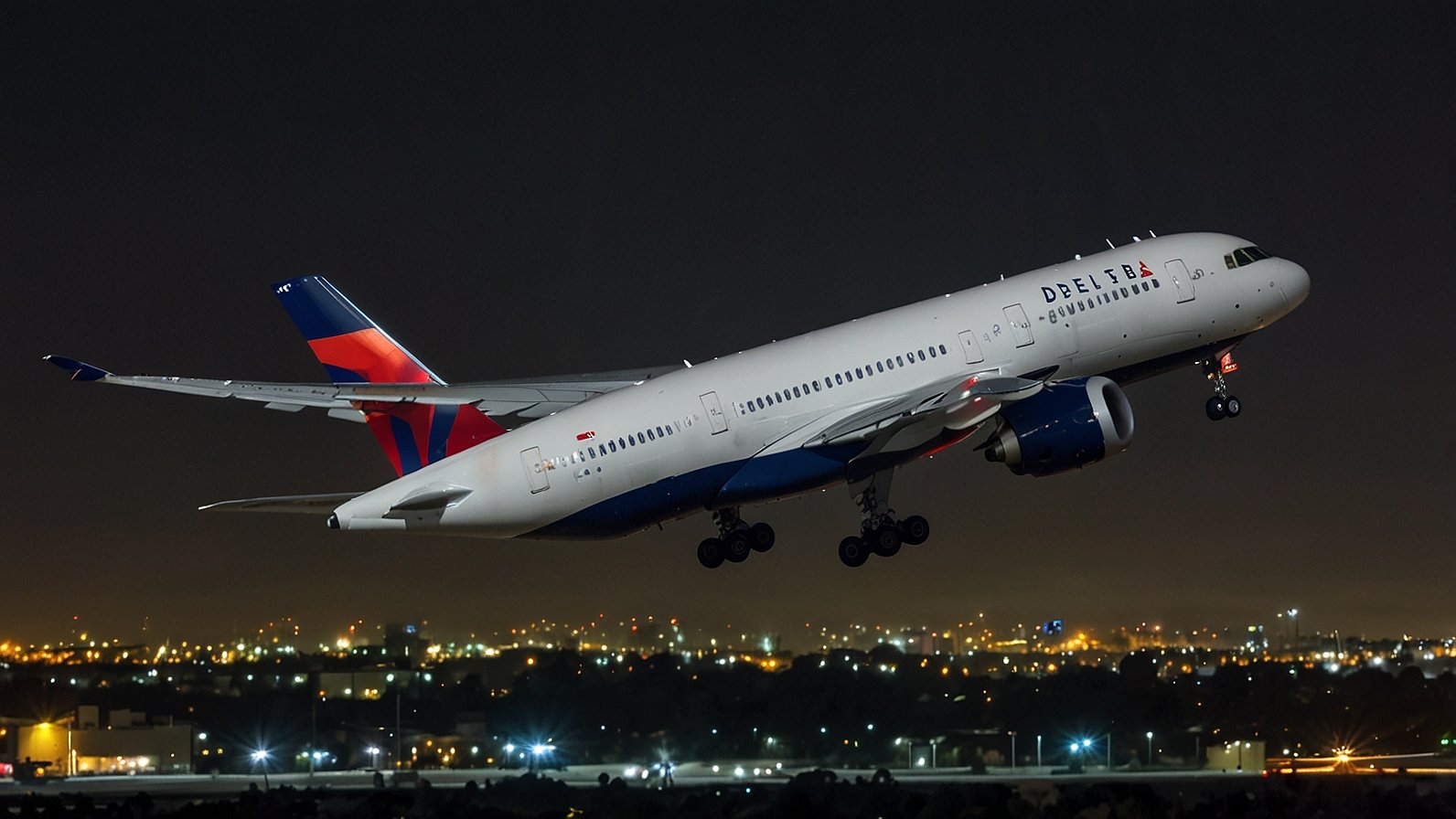Ever wonder what happens when a high-tech jetliner cruising miles above the ocean suddenly needs to change course? That’s precisely the scenario passengers on Delta Air Lines Flight DL275 faced on May 27, 2025. This trans-Pacific journey took an unexpected turn, leading to the Delta Flight DL275 diverted LAX after a critical system alert. Let’s unpack this incident, highlighting the swift actions taken to ensure everyone’s safety.
The Unexpected Turn: Flight DL275’s Timeline
Delta Flight DL275 was a routine scheduled service, an important link between Detroit Metropolitan Wayne County Airport (DTW) and Tokyo’s bustling Haneda Airport (HND). Operated by a modern Airbus A350-900 (registered N508DN), the flight took off as planned.
- Mid-Flight Alert: While cruising over the vast Pacific Ocean, the flight crew received an indication of a malfunction. Specifically, the monitoring systems flagged a failure within the anti-ice system of one of the aircraft’s powerful Rolls-Royce Trent XWB engines.
- Critical Decision: Faced with this technical issue, the pilots, following stringent safety protocols, made the immediate and prudent choice to discontinue the flight to Tokyo. Engine anti-ice systems are vital for safe operation in potential icing conditions, which can occur unexpectedly at high altitudes.
- Diverting to LAX: After assessing options, Los Angeles International Airport (LAX) was selected as the safest and most suitable diversion point. Key reasons for choosing LAX included:
- Long Runways: Providing ample margin for landing a large aircraft, especially under non-standard conditions.
- Advanced Facilities: LAX boasts significant maintenance capabilities and resources, crucial for diagnosing and addressing the engine issue.
- Strategic Location: Offering robust passenger support infrastructure and numerous onward flight connections.
- Safe Landing: Flight DL275 touched down smoothly at LAX at 1:38 AM Pacific Daylight Time on May 28, 2025. Importantly, no injuries were reported among the passengers or crew – the primary goal achieved.
Why LAX Was the Right Call for DL275
Choosing where to divert a long-haul flight isn’t arbitrary. Safety is always paramount. For Delta Flight DL275 diverted LAX, the decision was driven by several critical factors beyond just geography:
- Engineering Expertise on Hand: LAX is a major maintenance hub for Delta and other carriers. This meant specialized technicians and the necessary equipment were readily available to inspect the Trent XWB engine thoroughly upon landing. The chart below shows major US diversion airports ranked by maintenance facility capabilities.
- Infrastructure for Large Aircraft: The Airbus A350-900 is a massive wide-body jet. LAX’s runways, taxiways, and gates are designed to comfortably handle aircraft of this size, minimizing any additional operational risks during the diversion.
- Passenger Care Capabilities: Diverting hundreds of passengers requires significant ground support – from customs and immigration (for an international flight landing unexpectedly in the US) to rebooking desks, accommodation arrangements, and customer service staff. LAX has the scale to manage this efficiently.
- Operational Flexibility: With numerous daily Delta flights operating to and from LAX, finding alternative travel options for affected passengers was significantly easier than at a smaller airport.
Passenger Handling: Getting Travelers Back on Track
Delta’s response didn’t end with the safe landing. Handling the disruption smoothly was crucial:
- Segment Cancellation: Recognizing the time needed for diagnosis, potential repairs, and crew rest requirements, Delta promptly canceled the onward leg from LAX to Tokyo Haneda (HND).
- Swift Rebooking: Delta’s operations team worked diligently to re-accommodate affected passengers. This involved:
- Placing passengers on the next available Delta flights to Tokyo.
- Utilizing partner airlines (like Japan Airlines within the SkyTeam alliance) for alternative routing if needed.
- Providing hotel accommodations and meal vouchers for passengers facing significant delays.
- Communication: While details of passenger communication haven’t been fully disclosed, standard procedure involves regular updates via airport announcements, the Delta app, and staff on the ground to keep travelers informed about rebooking progress and next steps. This focus on “irregular operations” (IROPS) is a key part of airline customer service.
Understanding the Trent XWB Engine & Anti-Ice Systems
The heart of this incident involved the Rolls-Royce Trent XWB engine, specifically designed for the Airbus A350. Let’s break down the key component:
- The Trent XWB Engine: Known for its efficiency and reliability, powering most of the A350 fleet. Like all modern turbofans, it’s incredibly complex.
- Anti-Ice Systems: Why They Matter: At high altitudes, where temperatures plummet well below freezing, moisture in the air can instantly turn to ice upon contact with aircraft surfaces. Ice buildup on engine inlets or internal components is extremely dangerous. It can disrupt smooth airflow, potentially causing engine performance issues or even failure.
- How Engine Anti-Ice Works: Typically, these systems use hot air bled off from the engine’s compressor stages. This hot air is ducted to critical areas like the engine inlet lip and fan blades to prevent ice from forming or to melt any accumulation.
- The Significance of a Failure: An anti-ice system failure doesn’t automatically mean an engine will stop working. However, it does mean the aircraft cannot safely operate in known or forecast icing conditions. Pilots are trained to treat such failures seriously, often requiring descent to warmer air or diversion, as was the case with DL275. It’s a precautionary measure rooted in rigorous safety standards.
Aviation Safety: Procedures Working as Intended
You might wonder, “Was diverting such a long flight really necessary for an anti-ice system?” This incident actually showcases the aviation safety system functioning correctly:
- Redundancy is Key: Modern aircraft like the A350 are built with multiple layers of redundancy. While one system failed, others remained operational. However, procedures dictate conservative actions when critical systems are impaired.
- Pilot Training & Discretion: Pilots undergo extensive simulator training for exactly these scenarios. They have checklists and the authority to make decisions prioritizing safety above schedule or cost. The DL275 crew exercised sound judgment.
- Conservative Culture: Aviation operates on a fundamental principle: “It’s better to be on the ground wishing you were in the air, than in the air wishing you were on the ground.” Diverting may seem drastic, but it erases the risk associated with the unknown – like unexpectedly encountering severe icing.
- Regulatory Oversight: Strict regulations govern aircraft maintenance and operation. Continuing a flight with a known anti-ice system failure into potential icing would violate these rules.
Key Takeaways from the Delta Flight DL275 Diversion
This event, while disruptive for passengers, serves as a powerful reminder of how modern aviation prioritizes safety:
- Safety Trumps Schedule: The decision to divert DL275 8+ hours back to LAX was driven solely by precaution and procedure. No risk was taken with passenger safety.
- Infrastructure is Vital: Airports like LAX play a crucial role as safety net diversion points due to their facilities and resources.
- Crew Training Saves the Day: Pilots are rigorously trained to handle system malfunctions calmly and decisively.
- Technical Systems Have Safeguards: While complex systems can fail, aircraft design includes redundancies, and procedures exist to manage those failures safely.
- Airlines Plan for Disruptions: Delta’s rapid passenger rebooking demonstrates that while diversions are rare, airlines have protocols to manage the fallout.
What aspect of how airlines handle unexpected events like this impresses you the most? Is it the crew’s composure, the engineering behind the scenes, or the logistical scramble to help passengers?
You May Also Read: 7 Tips You Can Follow for Faster Car Crash Recovery
FAQs
Q: What date was Delta Flight DL275 diverted LAX?
A: The diversion occurred on May 27, 2025, with the aircraft landing at LAX at 1:38 AM PDT on May 28, 2025.
Q: Why did DL275 divert to Los Angeles (LAX)?
A: The flight diverted after the crew detected a failure in the anti-ice system of one of its Rolls-Royce Trent XWB engines. LAX was chosen for its long runways, advanced maintenance facilities, and passenger handling capabilities.
Q: Where was DL275 originally flying from and to?
A: The flight was operating from Detroit Metropolitan Airport (DTW) to Tokyo Haneda Airport (HND).
Q: Was anyone injured when DL275 diverted?
A: No. Reports confirmed there were no injuries to passengers or crew. The landing at LAX was safe.
Q: What happened to the passengers after landing at LAX?
A: The onward flight to Tokyo (HND) was canceled. Delta promptly rebooked affected passengers onto alternative flights to their destination.
Q: What type of aircraft was involved?
A: The flight was operated by an Airbus A350-900, registration N508DN.
Q: Is an anti-ice system failure dangerous?
A: While not causing immediate engine failure, it prevents the aircraft from safely flying in potential icing conditions. Diversion is a standard safety precaution mandated by regulations and procedures.











